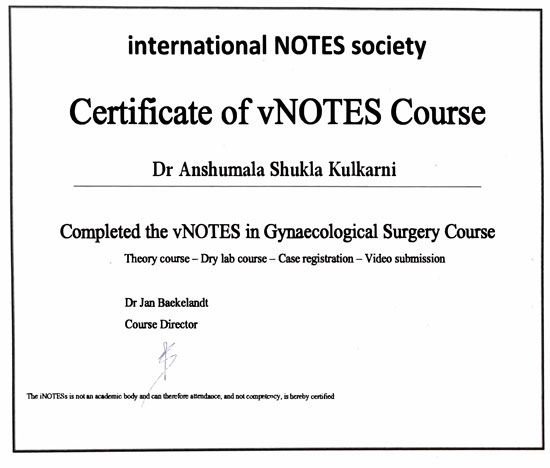Vaginal Natural Orifice Transluminal Endoscopic Surgery (vNOTES)
Vaginal Natural Orifice Transluminal Endoscopic Surgery (vNOTES) is a new procedure that combines laparoscopic and transvaginal surgery.
Many laparoscopic surgery may now be done transvaginally, which can greatly minimize postoperative pain, time to recovery, hospitalization duration, and scar.

What conditions are treated by the vNOTES procedure?
Adnexal pathology (ovarian cysts etc)
Abnormal uterine bleeding
Chronic pelvic pain
Fibroids
Prolapse of the uterus
Why should surgeons perform vNOTES?
This procedure combines the finest aspects of vaginal and laparoscopic surgery. . The majority of vNOTES treatments are outpatient procedures with minimal postoperative pain medication. Most people recover completely within two weeks after surgery.
The distance between the surgeon and the operational field is less than with abdominal laparoscopy, resulting in less instrument collision and the use of wider scopes with enhanced vision.
A vNOTES method also takes the primary blood supply to the uterus very early, which may greatly limit blood loss.
In patients with significant adhesions from past upper and mid abdominal surgery, vNOTES may completely eliminate these adhesions. The majority of surgeons perform this surgery comfortably and are considerably superior with less muscular strain than traditional laparoscopy. Obese patients benefit the most from avoiding abdominal incisions and recovering quickly.
What happens during the vNOTES procedure?
Instead of making visible abdominal incisions, your doctor will utilize specialized devices introduced via the vagina to perform the vNOTES surgery. This permits your doctor to obtain access to the uterus, fallopian tubes, and ovaries without making any visible incisions.
What can be expected before, during, and after the vNOTES procedure?
Your doctor will advise you on any pre-surgical testing and advice for eating, drinking, and taking medicines before the surgery.
The following will occur during the vNOTES procedure:
A vaginal incision is performed, and a specialized vNOTES device is inserted to provide your doctor access to the uterus, fallopian tubes, and ovaries.
To provide your doctor the necessary space to look and operate, the abdomen is inflated with carbon dioxide gas (similar to standard laparoscopic surgery).
Through the vNOTES device, a highly defined camera and specialized equipment are implanted, enabling your doctor to operate with maximum accuracy and visualization.
The vNOTES device is removed after the procedure, the gas is expelled, and the internal incisions are closed.
Patient discharged the same day after surgery.
Application of Vnotes in gynecology surgery
Gynecological surgery
Since 2012, over 400 hysterectomies done with vNOTES have been documented in the literature. vNOTES hysterectomy has been used to treat almost all uterine pathology, including uteri weighing more than 2000 g. Myomectomy may also be done using a vNOTES technique.
Endometrial cancer
Endometrial cancer patients are often obese and have several medical comorbidities. There have been several accounts of transvaginal hysterectomy being performed on individuals who are unable to endure abdominal surgery. However, this method does not always allow for the viewing and removal of the tubes and ovaries. VNOTES allows for the removal of the tubes and ovaries, as well as a pelvic wash, examination of the abdomen, and removal of lymph nodes. Numerous studies in the literature demonstrate the ability to perform Sentinel lymph nodes as well as pelvic lymphadenectomy and even aortic lymphadenectomy using this method.
Ovarian cancer
There are several exceptions to the rule that ovarian cancer debulking is not done using a minimally invasive approach. When patients have a great response to neoadjuvant chemotherapy, a robotic or laparoscopic method might be used to eliminate any small remaining tumor. This minimally invasive approach may also be used to grade early stage cancer. A vNOTES method may remove adnexal tumors, lymph nodes, and do a comprehensive abdominal cavity examination.
Cervical Carcinoma
vNOTES may be used to execute a radical vaginal hysterectomy, and since pelvic lymph nodes can be excised, it is only a matter of time until some surgeons become experienced enough to perform such a procedure.
Non-gynecologic procedures
In most cases, laparoscopic appendectomy is a simple surgery that may be performed safely using the vNOTES technique. Abdominal wall adhesions may be visualized and safely removed, which may reduce some patients’ abdominal pain symptoms. Small umbilical hernias may be closed or repaired with mesh against the abdominal wall with this technique.
Benefits of vNOTES
Shorter hospital stay: When compared to other procedures, patients who have surgery are discharged home in less than 24 hours in most circumstances.
No visible scars: Other procedures, whether laparoscopic or open, leave visible scars on the abdomen. A vaginal incision avoids visible scarring in the case of vNOTES.
Minimal discomfort: minimal discomfort As a consequence, post-operative patients use less pain medication for a shorter period of time.
Faster recovery: Some patients were able to return to work less than a week following surgery. Other gynecologic laparoscopic procedures need a 2-4 week recovery period.

Dr. Anshumala Shukla-Kulkarni
MD, FCPS, DGO
Gynaecologist, Laparoscopic & Robotic Surgeon

